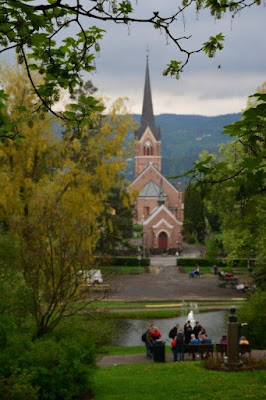If one is young, healthy and well-rested (Hey, a .333 average gets you into the Baseball Hall of Fame), one can take advantage of the ’
Oslo Pass.’ Many cities offer one- or two-day tickets that permit entry to a bunch of the town’s cultural attractions. The Oslo version was even better since it included the use of all forms of public transportation. On Day 14, we blitzed the town and put the passes to good use.
Oslo Lilacs (21 May 2019)
We walked through central city to the harbor, passing through the government center. The lilacs here are in front of the
national parliament building. This is the most laden, richly-adorned lilac I have ever seen.
From the waterfront near the
City Hall (where the Nobel Peace Prizes are awarded every year), we hopped a ferry to another side of the fjord and the
Viking Ship Museum. The museum displays wonderfully-preserved, 1200-year old Viking boats. Silly me. I saw too many Hollywood depictions of Viking funerals and thought the boats were set adrift with the deceased and torched. Turns out the wealthy dead and their boats were buried together. The boats and the artifacts buried with the decedent can be preserved quite well under certain soils.
Viking Ship Museum, Oslo (21 May 2019)
Next stop was the Polar Ship
‘Fram’ Museum. Like the ’Vasa’ Museum in Stockholm, it is an exhibit building built around the ship. Norwegians were prominent polar explorers at the early 20th century and the museum is a vivid depiction of the lives and times of the hearty souls who drove deeper toward the ends of the earth…without the aid of satellite imagery, air-dropped supplies and the internet…Oh, the Hardship and Deprivation! The impression is enhanced by projected polar imagery on the white A-frame walls with accompanying sound effects.
‘Fram’ Museum, Oslo (21 May 2019)
Next stop was the museum dedicated to the Norwegian icon, 20th century expressionist painter,
Edvard Munch. This time, we took the underground, a fine, modern subway system with one glaring difference compared with its American counterparts. I grew up riding the old New York City subways and often use the Washington Metro. Here, you can’t get close to a train without buying tokens or fare cards that allow you to pass though the turnstiles, fences and other barriers that separate those who bought tickets from those who didn’t. Oslo’s subway is essentially an extension of the street. Go downstairs and get on the train. Of course, they sell tickets and I guess there actually are authorities who randomly check to see if passengers are really honest. Apparently, the threat of a hefty fine deters most riders from freeloading. Nonetheless, I was impressed since I’m sure so many of us ‘Exceptional’ Americans would be all too pleased to screw the authorities out of a fare.
‘Madonna’ (1894) by Edvard Munch,
Munch Museum, Oslo (21 May 2019)
Everyone knows ‘
The Scream.’ You can’t throw a rock without hitting some appropriation of the image. It was here but I’m not showing it. You’ve seen it enough. In 2004, armed thieves stole ‘
The Scream’ and ‘
Madonna’ in a daring daylight robbery. It took two years to recover the works.
I am not much impressed by Munch’s style and his overall output. But what do I know? He is a national treasure here. A much bigger museum is under construction downtown so future visitors will have a much better venue than the current leaky, threadbare location.
Downtown Oslo 2019 – Tower Cranes and Naked Statues (21 May 2019)
Another subway ride took us back to the central city waterfront where we wandered through the
Akershus Fortress, a medieval fort and royal residence that is now more of a museum and event center. After that, Frank and Suzanne had enough and returned to the apartment while Beck and I soldiered on to one more stop.
The shot above summarizes this American’s impression of today’s Oslo…bustling and growing. Tower cranes sprout in every direction as do anatomically-correct statues. I know the human body has forever been the object of artistic expression and the nude is the best way to be classical and timeless. I just appreciate the progressive Scandinavian acceptance of all that is the human form…and couldn’t help but wonder how our petty Puritan protesters stateside would respond to this pubic art.
On the left above is the
Nobel Peace Center. The 19th century rail station was transformed in 2005 to house permanent displays of the Nobel Peace Prize recipients and temporary exhibits on related subjects.
Nobel Peace Center, Oslo (21 May 2019)
The heart of the Peace Center is the Nobel Field, a dark room where one can find the 130 honorees and their stories. Among the American recipients are Teddy Roosevelt (1906 – for mediating the end of the Russo-Japanese War); Woodrow Wilson (1919 – for his role in forming the League of Nations); Martin Luther King (1964) and Norman Borlaug (1970 – for developing the ‘miracle’ grains that boosted food production throughout the third world).
After that, we were exhausted and foot-sore. We limped back to the apartment after visiting four museums via boats, street cars, buses and subways. A very full day indeed.

















